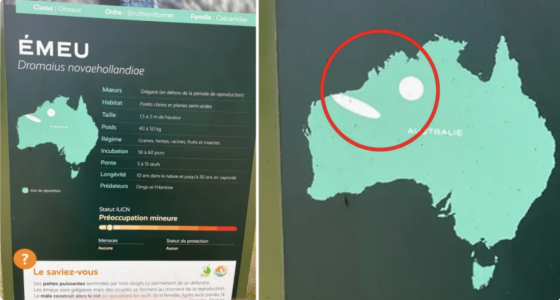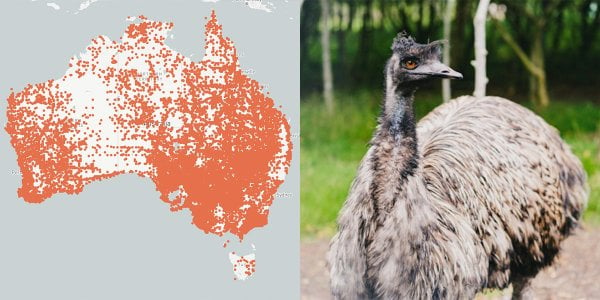Why are Aussies losing it over this strange detail in a French zoo?
By
Seia Ibanez
- Replies 8
France is known for many wonderful things—its stunning sights, historical appeal, and irresistible cuisine, to name just a few.
But there's one area where France might need a bit of help—their knowledge about Australian wildlife at one particular zoo.
One wildlife enthusiast shared an image of a map of Australia displayed at a French zoological park on social media.
The map, located outside an emu enclosure, was meant to show where these native animals can be found around Australia.
The map showed the green parts as those areas where emus are found, plus two little shapes—one small circle and one elongated oval—in Western Australia's northwest showed where they could not be found.
As simple as the map appeared, eagle-eyed Aussies saw a different story and laughed at what they said was a ‘strange’ lack of ‘fact-finding’..
According to a detailed interactive map put together by Australian researchers at the Atlas of Living Asia, the French map is inaccurate.
Tyler Lower, Mammals & Birds Keeper at the Australian Reptile Park, explained that the map was ‘definitely oversimplified’.
‘As for why emus have a limited distribution within this area, it will mainly be due to the climate not being sufficient enough for them to stay there,’ he said.
‘Between the NT and WA border, it's an arid climate and most likely [an area where they are not found].'
Lower pointed to a more accurate map, which you can check below:
The ensuing confusion prompted people online to guess why the zoo got it wrong.
'I'm guessing that the zoo just decided that your everyday Joe just isn’t that bothered by the accuracy of those maps,' one said.
‘To be fair, few tourists would be willing to travel to whoop whoop to verify it themselves,’ another joked.
‘I don’t blame [them]. I live in WA, and I’m not going there to check either,’ a third added.
Not only does the map wrongly shrink the distribution area of the emus, but it also overlooks the fact that there are no wild emus in Tasmania.
Where can emus be found?
The Australia Museum said the birds were once found in Tasmania but were driven to extinction.
‘The Emu is found only in Australia (naturally),’ the museum said.
‘It lives throughout most of the continent, ranging from coastal regions to high in the Snowy Mountains. Emus were once found in Tasmania but were exterminated soon after Europeans arrived.’
‘Two dwarf species of emus that lived on Kangaroo Island and King Island also became extinct,’ it added.
The museum also highlights that emus move within their ranges according to climatic conditions.
‘If sufficient food and water are present, the birds will reside in one area.’
‘Where these resources are more variable, emus move as needed to find suitable conditions. They are known to move hundreds of kilometres, sometimes at rates of 15 km to 25 km per day,’ the museum stated.
As for the wild emu’s population, they are between 625,000 to 725,000 in number.
While the zoo map may not be accurate, reports said other facts mentioned appeared to be accurate when translated.
If you ever see an emu, you may think going near them could be harmless, but as any true blue Aussie knows: they are dangerous creatures. A previous story we shared serves as an apt reminder of the importance of keeping a safe distance from native birds. You can check out the story here.

Members, have you seen an emu in your area? Do you think zoos have been fact-checking their information before showing it to the public? Let us know your thoughts in the comments below!
But there's one area where France might need a bit of help—their knowledge about Australian wildlife at one particular zoo.
One wildlife enthusiast shared an image of a map of Australia displayed at a French zoological park on social media.
The map, located outside an emu enclosure, was meant to show where these native animals can be found around Australia.
The map showed the green parts as those areas where emus are found, plus two little shapes—one small circle and one elongated oval—in Western Australia's northwest showed where they could not be found.
As simple as the map appeared, eagle-eyed Aussies saw a different story and laughed at what they said was a ‘strange’ lack of ‘fact-finding’..
According to a detailed interactive map put together by Australian researchers at the Atlas of Living Asia, the French map is inaccurate.
Tyler Lower, Mammals & Birds Keeper at the Australian Reptile Park, explained that the map was ‘definitely oversimplified’.
‘As for why emus have a limited distribution within this area, it will mainly be due to the climate not being sufficient enough for them to stay there,’ he said.
‘Between the NT and WA border, it's an arid climate and most likely [an area where they are not found].'
Lower pointed to a more accurate map, which you can check below:
The ensuing confusion prompted people online to guess why the zoo got it wrong.
'I'm guessing that the zoo just decided that your everyday Joe just isn’t that bothered by the accuracy of those maps,' one said.
‘To be fair, few tourists would be willing to travel to whoop whoop to verify it themselves,’ another joked.
‘I don’t blame [them]. I live in WA, and I’m not going there to check either,’ a third added.
Not only does the map wrongly shrink the distribution area of the emus, but it also overlooks the fact that there are no wild emus in Tasmania.
Where can emus be found?
The Australia Museum said the birds were once found in Tasmania but were driven to extinction.
‘The Emu is found only in Australia (naturally),’ the museum said.
‘It lives throughout most of the continent, ranging from coastal regions to high in the Snowy Mountains. Emus were once found in Tasmania but were exterminated soon after Europeans arrived.’
‘Two dwarf species of emus that lived on Kangaroo Island and King Island also became extinct,’ it added.
The museum also highlights that emus move within their ranges according to climatic conditions.
‘If sufficient food and water are present, the birds will reside in one area.’
‘Where these resources are more variable, emus move as needed to find suitable conditions. They are known to move hundreds of kilometres, sometimes at rates of 15 km to 25 km per day,’ the museum stated.
As for the wild emu’s population, they are between 625,000 to 725,000 in number.
While the zoo map may not be accurate, reports said other facts mentioned appeared to be accurate when translated.
If you ever see an emu, you may think going near them could be harmless, but as any true blue Aussie knows: they are dangerous creatures. A previous story we shared serves as an apt reminder of the importance of keeping a safe distance from native birds. You can check out the story here.
Key Takeaways
- A wildlife enthusiast shared an image of a map from a French zoological park that inaccurately depicts where emus reside in Australia.
- The inaccuracies on the map include an incorrect depiction of the areas in Western Australia where emus do not live while also neglecting to indicate that there are no wild emus in Tasmania.
- Tyler Lower, a keeper at the Australian Reptile Park, commented that the map is 'definitely oversimplified' and offered a more realistic depiction of emu distribution in Australia.
- Despite the inaccuracies, other facts about emus translated into French at the zoo appeared correct.









